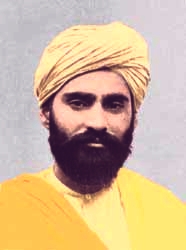Sadhu Sundar Singh
Indian Christian missionary
Biography
Singh was raised a member of the Sikh religion. Prior to his conversion, Sundar attended a primary school run by the American Presbyterian Mission where the New Testament was read daily as a "textbook." Sundar "refused to read the Bible at the daily lessons...To some extent the teaching of the Gospel on the love of God attracted me, but I still thought it was false."
In the midst of such confusion and while only fourteen years old, his mother died, and Sundar underwent a crisis of faith. His mother was a loving saintly woman and they were very close. In his anger, Sundar burned a copy of one of the Gospels in public. Within three days Sundar Singh could bear his misery no longer. Late one night in December 1903, he rose from bed and prayed that God reveal himself to him if he really existed. Otherwise -- "I planned to throw myself in front of the train which passed by our house." For seven hours Sundar Singh prayed. "O God, if there is a God, reveal thyself to me tonight." The next train was due at five o'clock in the morning. The hours passed. Suddenly the room filled with a glow. A man appeared before him. Sundar Singh heard a voice say, "How long will you deny me? I died for you; I have given my life for you." He saw the man's hands, pierced by nails.
Amazed that his vision had taken the unexpected form of Jesus, Sundar was convinced in his heart that Jesus was the true Savior, and that He was alive. Sundar fell on his knees before Him and experienced an astonishing peacefulness which he had never felt before. The vision disappeared, but peace and joy lingered within him.
Despite his family's pleas, bribes, and threats, Sundar wanted to be baptized in the Christian faith. After his father spoke words of official rejection over him, Sundar became an outcast from his people. He cut off the hair he had worn long like every Sikh man. Against great opposition, he was baptized on his birthday in 1905, in an English church in Simla.
Conventional Indian churches were willing to grant him a pulpit, but their rules were foreign to his spirit. Indeed, he felt that a key reason the gospel was not accepted in India was because it came in a garb foreign to Indians. He decided to become a sadhu, so that he could dedicate himself to the Lord Jesus. He was convinced that this was the best way to introduce the Gospel to his people since it was the only way which his people were accustomed to. As a sadhu, he wore a yellow robe, lived on the charity of others, abandoned all possession and maintained celibacy. In this lifestyle, he was free to devote himself to the Lord. Dressed in his thin yellow robe, Sundar Singh took to the road and began a life of spreading the simple message of love and peace and rebirth through Jesus. He carried no money or other possessions, only a New Testament.
Sundar journeyed much. He traveled all over India and Ceylon. Between 1918-1919, he visited Malaysia, Japan and China. Between 1920-1922 he went to Western Europe, Australia and Israel. He preached in many cities; Jerusalem, Lima, Berlin and Amsterdam among others. Despite his growing fame, Sundar retained a modest nature, desiring only to follow Jesus' example: to repay evil with kindness and to win over his enemies by love.
He was quite independent of outward Church authority in all his religious life, thought, and work. He dropped out of a Christian seminary that he briefly attended. Neither did he attach much importance to public worship because in his experience the heart prays better in solitude than in a congregation.
He traveled in India and Tibet, as well as the rest of the world, with the message that the modern interpretation of Jesus was sadly watered down. Sundar visited Tibet every summer and in 1929, he visited there and was never seen again.

